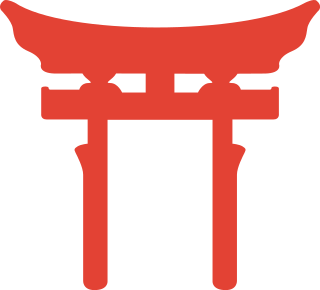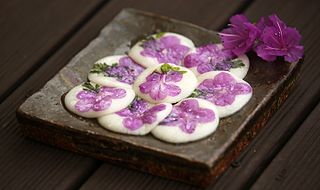Related Research Articles

The peach is a deciduous tree native to the region of Northwest China between the Tarim Basin and the north slopes of the Kunlun Mountains, where it was first domesticated and cultivated. It bears an edible juicy fruit called a peach or a nectarine.

Japanese festivals are traditional festive occasions. Some festivals have their roots in Chinese festivals centuries ago, but have undergone great changes as they mixed with local customs.

Chrysanthemums, sometimes called mums or chrysanths, are flowering plants of the genus Chrysanthemum in the family Asteraceae. They are native to Asia and northeastern Europe. Most species originate from East Asia and the center of diversity is in China. Countless horticultural varieties and cultivars exist.

A cherry blossom is a flower of many trees of genus Prunus. The most well-known species is the Japanese cherry, Prunus serrulata, which is commonly called sakura.

Prunus mume is an East Asian tree species classified in the Armeniaca section of the genus Prunus subgenus Prunus. Its common names include Chinese plum,Japanese plum and Japanese apricot. The flower, long a beloved subject in the traditional painting and poetry of East Asia, is usually called plum blossom. This distinct tree species is related to both the plum and apricot trees. Although generally referred to as a plum in English, it is more closely related to the apricot. In Chinese, Japanese, Korean and Vietnamese cooking, the fruit of the tree is used in juices, as a flavouring for alcohol, as a pickle and in sauces. It is also used in traditional medicine.

Muan County (Muan-gun) is a county in South Jeolla Province (Jeollanam-do), South Korea. In 2005, Muan County became the capital of Jeollanam-do following the transfer of the provincial office from its previous location, Gwangju to the village of Namak in Muan. Muan International Airport was opened here, and will eventually replace the airports in Gwangju and Mokpo.

Hanami is the Japanese traditional custom of enjoying the transient beauty of flowers; flowers ("hana") are in this case almost always referring to those of the cherry ("sakura") or, less frequently, plum ("ume") trees. From the end of March to early May, cherry trees bloom all over Japan, and around the first of February on the island of Okinawa. The blossom forecast "cherry blossom front" is announced each year by the weather bureau, and is watched carefully by those planning hanami as the blossoms only last a week or two.
A blossom is the flower of stone fruit trees and some other small plants.

The National Cherry Blossom Festival is a spring celebration in Washington, D.C., commemorating the March 27, 1912, gift of Japanese cherry trees from Mayor Yukio Ozaki of Tokyo City to the city of Washington, D.C. Mayor Ozaki donated the trees to enhance the growing friendship between the United States and Japan and also celebrate the continued close relationship between the two nations. Large and colorful helium balloons, floats, marching bands from across the country, music and showmanship are parts of the Festival's parade and other events.

The Dogwood Arts Festival is an annual event in Knoxville, Tennessee, sponsored by Dogwood Arts, a 501(c)3 nonprofit organization whose mission is to promote and celebrate regional art, culture, and natural beauty. The event is held in April and celebrates the blooming of the dogwood trees. It includes a parade, a house and garden show, and demonstrations of various Appalachian arts and crafts such as quilting, bluegrass music, and doll-making. Many events are held in Market Square in downtown Knoxville. Additionally, driving trails are marked in Knoxville and the surrounding area for people to view the dogwoods in bloom.

Century Park is the largest park in the city of Shanghai. It is situated on Jinxiu Road, in the Pudong New Area of Shanghai, nearby to the Shanghai Science and Technology Museum.

The International Cherry Blossom Festival is held in Macon, Georgia every spring. Macon, known as the "Cherry Blossom Capital of the World," has around 300,000–350,000 Yoshino Cherry Trees that bloom around the city in late March every year. The festival lasts for ten days and features events for people of all ages. The festival is not associated with the National Cherry Blossom Festival held in Washington, D.C.

Hwajeon, or flower cake is a small Korean pan-fried rice cake. It is made out of glutinous rice flour, honey and edible petals from seasonal flowers, such as rhododendron. It is eaten during the festivals of Samjinnal and Buddha's Birthday.

A flower parade is a parade in which the floats, vehicles, boats, participants, animals and other things are decorated or covered in flowers. Often there are other elements like marching bands and people in costumes. Flower parades are held in several countries, many of which celebrate the forthcoming of the seasons. The oldest flower parade dates back to the 1800s.

The National Flower of the Republic of China was officially designated as the plum blossom by the Executive Yuan of the Republic of China (Taiwan) on July 21, 1964. The plum blossom, known as the meihua, is symbol for resilience and perseverance in the face of adversity, because plum blossoms often bloom most vibrantly even amidst the harsh winter snow. As the plum tree can usually grow for a long time, ancient trees are found throughout China. Huangmei county in Hubei features a 1,600-year-old plum tree from the Jin Dynasty which is still flowering. The three stamens represents Dr. Sun Yat-sen's Three Principles of the People, while the five petals symbolize the five branches of the government: Executive Yuan, Legislative Yuan, Judicial Yuan, Examination Yuan and Control Yuan. The flower has also been proposed to be one of the national flowers for the People's Republic of China.

Paeonia × suffruticosa is a name used for a group of culture varieties of tree peonies that are the result of hybridisation with species exclusively belonging to the subsection Vaginatae. The common name used in China is mǔdān. Plants belonging to this group have been cultivated for millennia in China, initially only as a source of traditional Chinese medicine particularly the skin of its roots. Already early on the plant was also cultivated for its ornamental value, and it is highly revered in Chinese culture.

Yushima Tenman-gū (湯島天満宮) is a Shinto shrine located in the Bunkyō ward of Tokyo, Japan.
Ballarat Begonia Festival is a carnival and community cultural festival held annually in Ballarat, Victoria, Australia. Run since 1953, it is a major tourist attraction of the city. Themed around the begonia flower which blooms in the temperate Ballarat climate, traditional features of the festival programme include floral displays and plantings on the main city streets, a centrepiece parade down Sturt Street including floats constructed by local community groups including sporting clubs, businesses, educational institutions, musicians and special interest groups and military tattoo.
Julia Lester Dillon (1871—1959) was a teacher from Georgia, who because of the death of her husband and her hearing loss, trained in landscape architecture. She was one of the first women to write extensively about gardening in the south and ran a regularly featured column which appeared in several newspapers and magazines. She designed spaces to enhance post offices for the U.S. Department of the Treasury and created the Memorial Park in Sumter, South Carolina. Based on her experience, she then served as Sumter Superintendent of Parks and Trees for twenty years. Dillon remained in Sumter after retiring. She continued writing until 1954, despite losing both her hearing and her sight. Julia Lester Dillon died in Sumter on March 24, 1959. She is buried in Magnolia Cemetery in Augusta Georgia. She was inscribed upon the Georgia Women of Achievement roster in 2003.
The Benguet–Kōchi Sisterhood Park is a park in barangay Paoay of the town of Atok, Benguet in the Philippines.
References
- 1 2 3 4 5 6 Binheim, Max; Elvin, Charles A (1928). Women of the West; a series of biographical sketches of living eminent women in the eleven western states of the United States of America. p. 94 . Retrieved 8 August 2017.

- 1 2 "Mrs. Nellie White to be Laid to Rest - 17 Sep 1952, Wed • Page 20". The Los Angeles Times: 20. 1952. Retrieved 4 October 2017.
- ↑ "Mrs. Nellie A. White Presides Over Initial Gathering of New Organization - 17 Mar 1936, Tue • Page 1". Arcadia Tribune: 1. 1936. Retrieved 4 October 2017.